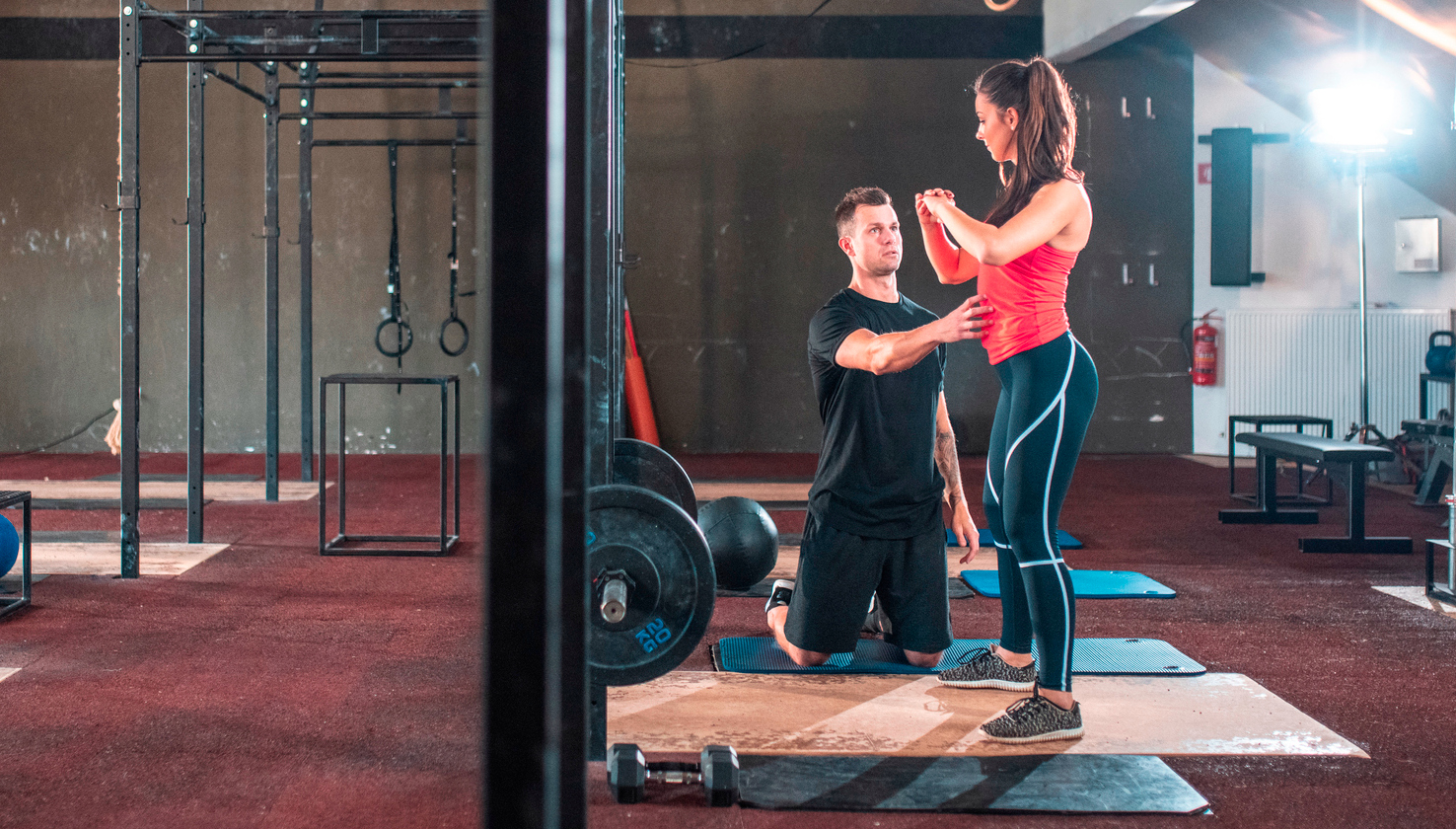
It’s mentioned in every exercise guide worth its salt, and uttered by every fitness instructor you’ll ever meet, but how do you actually engage your core? Which muscles does it involve? Which exercises can it help with? When should you engage and when should you disengage? We asked three experienced personal trainers to unpack this standard advice to help you make the most of your next workout.
Why should you engage your core?
Quite simply, if you want to avoid injury when doing anything strenuous, and especially when exercising or playing sports, you need to learn how to engage—or brace—your core.
Learning this will create "a strong midline that is vital for stabilizing, controlling and protecting your spine when performing daily tasks at home, within a workplace, at the gym or out exploring the world," says Kelli Vossler, director of fitness at Spark Fitness and Tennis in Andover, Massachusetts.
It can also help improve your posture throughout the day, "especially for people who are mostly seated for work, helping reduce wear and tear on the spine and alleviate lower-back pain," says Adam Enaz, personal trainer and transformation specialist.
But engaging your core isn’t just for injury prevention or postural support. It can also help create a figurative forcefield around your spine, allowing you to transfer power from your lower to your upper body—and vice versa—whether performing a loaded squat or simply bearing the brunt of a heavy backpack.
"It's impossible to lift with intensity without engaging your core—but it's a skill you have to learn and even experienced exercisers can get it wrong," says Eddie Baruta, global head of gym floor personal training at Ultimate Performance.
Which muscles are involved in engaging your core?

When people hear core they often think abs. This, says Baruta, is a common mistake. Someone might simply tense their rectus abdominis, the six-pack muscles that run along the front of your abdomen, hoping that’ll do the trick. But perform any form of loaded squat, like a goblet squat or thruster, and that approach will soon be your undoing.
Instead, Baruta prefers to talk about bracing the "trunk" muscles. "Think of your core as a balloon," he elaborates. "The top part is dominated by the diaphragm, the bottom by the pelvic floor, and the sides by the obliques and deep-lying transverse abdominis"—also known as the cummerbund muscle of the abdomen.
When engaging your core, the objective is to recruit all these muscles in unison so your midline and spine are supported front and back, top and bottom.
How to engage your core
Now we’ve covered the why and the which, it’s time to focus on the how. How do you effectively engage your core? To execute this, you should start with your breath.
1. Don’t suck
When engaging your core you might assume you need to suck your belly in, but that's counterproductive. "Sucking your belly in or hollowing your tummy and pulling your belly button toward your spine creates dysfunction in your midsection," says Baruta. Instead, you need to breathe in while letting your belly rise.
2. Breathe deep
To achieve this belly expansion, you need to take a deep diaphragmatic breath into the pit of your stomach, rather than a shallow breath into your chest. Baruta says a quick exercise to ensure the correct technique is to place one hand on your chest and another on your stomach. Breathe in and observe which hand rises first, then correct your breathing if necessary so that your belly rises as you inhale.
3. Create 360˚ tension
Next, with this breath, push your belly and lower back out. This is key. A tactile cue Vossler recommends here is to stand tall and place your hands on your obliques (your sides) just below the rib cage and press in slightly with your fingers against the side of your belly and thumbs against your lower back
Next, with your hands acting as a makeshift weight belt, allow your abdomen to expand front and back. "This is the same reaction you’d have if bracing as if expecting to be punched in the belly," she adds. "In order for this to happen, the back and abdominals engage to create stability and protect the spine."
4. Stay in neutral
Effective core bracing should keep your spine in a neutral alignment, Baruta stresses. In other words, you should avoid overly arching or curving your back. Practice in a mirror to see if you can maintain this alignment when dropping into an unweighted squat.
5. Press down
With your abdomen pressed out and spine in neutral, bring your rib cage down slightly and push out further to create as much intra-abdominal pressure as you can. This will create a platform that will allow you to add load without getting bent out of shape.
Cues that'll help you engage your core
Now you have the technique down, remember these cues to ensure you’re safely engaging your core every time.
"Brace your trunk"
As Baruta has mentioned, bracing the core requires all the muscles of the trunk to "switch on", not just the muscles along the front of your stomach. Visualizing muscles on the front, back and sides of the torso tends to trigger his clients into engaging all the muscles around the spine.
"Tighten the corset"
Enaz uses this cue with clients just before they unrack a bar from the squat rack or bench press. "Imagine you’re wearing a corset that wraps around your entire midsection—front, back and sides," suggests Enaz. "Now tighten it. I find that this visualization cue helps my clients engage the entire core musculature, not just the front abs."
"Tuck your pelvis"
A cue Vossler likes to use with athletes is to "pull the rib cage down and slightly tuck the pelvis under". Also known as the "posterior tilt", she finds it especially handy for floor-based exercises to help athletes switch on their core muscles and realign the spine.
"Reset at the top"
If you’re relatively new to lifting, Baruta recommends only resetting your breath once you’ve returned to a safe position, such as the top of a squat. As you become more accustomed to the technique you can start to exhale forcefully as you drive to stand. With a push-up, however, "you can exhale slightly earlier, like letting out a balloon as you press the floor away," he says.
"Remember to breathe"
Breath in at the start of a rep and breath out at the end. If holding an isometric position, like with the plank exercise, Enaz recommends trying to breathe as normally as possible. "It can take practice to breathe naturally while bracing the core, but it’s vital to maintain proper oxygen flow during exercise," he says. Baruta prefers to inhale through the nose and exhale through the mouth each rep.
What to avoid when engaging your core?
Sucking in your stomach
"Simply sucking in your stomach without properly engaging your deep core muscles will not effectively stabilize your spine or pelvis," warns Enaz.
Over tightening
Engaging your core doesn’t mean tensing up as hard as you can. "Over-tightening can lead to other muscles compensating, which can throw off alignment and reduce the effectiveness of your engagement," says Enaz.
Holding your breath
Forgetting to breathe is a surprisingly common mistake when trying to engage your core—especially during isometric exercises like planks or wall sits. The risk is that it can "increase blood pressure and decrease performance," says Enaz. "Learn to breathe through the engagement."
With an exercise like a dumbbell-loaded squat or deadlift, you can hold your breath momentarily to maintain intra-abdominal pressure during the movement, but you should always take a new breath and reset your core engagement between reps.
How to engage your core in practice

Here’s how incorporating all of these dos and don'ts to engage your core works in practice, with a dumbbell squat as the example.
- Stand holding a pair of medium-heavy dumbbells by your sides.
- Breathe in through your nose, allowing the air to travel deep into the pit of your tummy. As you breathe in, press your abdomen out, front and back, to support your spine.
- Lift the dumbbells to shoulder height, with your palms facing and elbows pointing forward.
- You can begin the movement or reset with another breath. To reset, allow a short exhale through your lips while maintaining tension in your trunk.
- Breathe in through your nose, press your abdomen out and pull your rib cage down to create maximum intra-abdominal pressure while keeping your spine neutral.
- Bend your knees and push your hips back to lower under control. Push your knees our wide and keep your chest facing forward.
- While still holding your breath to maintain tension in your core, drive through your heels powerfully and press your hips forward to stand tall.
- If you’re fully confident that you can maintain a tight core, exhale through your mouth as if letting air out of a balloon as you drive up to stand. Otherwise, exhale once you’re safely at the top of the rep.
- Reset with another nasal breath inhalation to engage your core and repeat.







